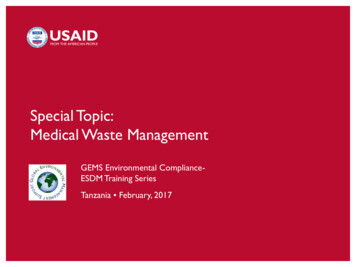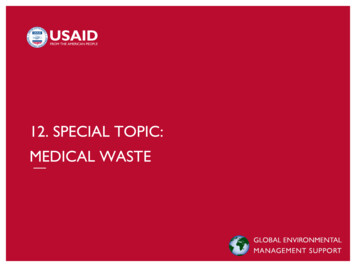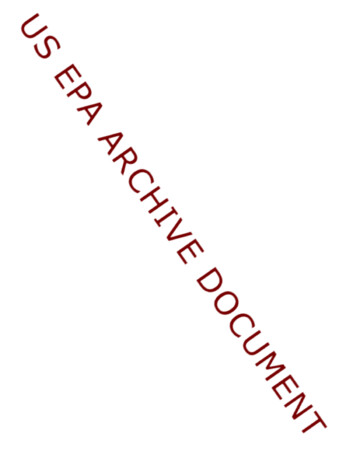
Transcription
Special Topic:Medical Waste ManagementGEMS Environmental ComplianceESDM Training SeriesTanzania February, 2017
SESSION OBJECTIVES Review the different types of medical waste Sensitize to the risks of improper disposal Understand medical waste management procedures Discuss environmental compliance and safeguards for effective wastemanagement3/5/2017Medical Waste Management2
TWO MAJOR TYPES OFMEDICAL WASTE General solid waste‒ Similar to domestic waste‒ Includes paper, plastic, packaging,food prep‒ No patient contact‒ 75 – 90% of healthcare facilitywaste is hazardous Hazardous waste3/5/2017Medical Waste Management3
HAZARDOUS WASTE Hazardous Waste includes:‒ Infectious waste (except sharpsand waste from patients withhighly infectious diseases)‒ Small quantities of chemicals andpharmaceuticals‒ Non-recyclable pressurizedcontainers Highly Hazardous waste is aseparate category3/5/2017Medical Waste Management4
HIGHLY HAZARDOUS WASTE Highly Hazardous includes:‒ Sharps‒ Highly infectious non-sharp waste‒ Stools from cholera patients‒ Bodily fluids of patients with highlyinfectious diseases‒ Large quantities of expired or unwantedpharmaceuticals and hazardouschemicals and radioactive wastes‒ Genotoxic wastes (affecting geneticcomposition and multiple generations)‒ Teratogenic wastes (affectingdevelopment of the exposed individual)3/5/2017Medical Waste Management5
WHAT ARE THE RISKS? Physical injury‒ Cuts, punctures (e.g., fromsharps) Disease transmission‒ Greatest and most immediatethreat‒ HIV/AIDS, hepatitis B & C Water supply contamination‒ Infectious stools or bodilyfluids Chemical and toxic‒ Pharmaceuticals‒ Heavy metals (mercury,cadmium)3/5/2017Medical Waste Management6
MANDATORY ENVIRONMENTAL REVIEW Reg. 216 applies!‒ Establishment or rehabilitationof health centers or clinics‒ Training or technical assistanceto health care providers orinstitutions—”health systemstrengthening” Environmental analysis (EA or IEE)prepared to determine nature andextent of risks EA/IEE conditions specify mitigationand monitoring criteria for medicalwaste management‒ Segregation and disposal‒ Use of personal protectiveequipment (PPE); training3/5/2017Medical Waste Management7
EFFECTIVE MEDICALWASTE MANAGEMENT Segregation & Disposal: Nonhazardous solid waste‒ Treat same as “domestic waste”‒ Reduces waste quantity, cost,risk from and to scavengers andworkers‒ Manage as close to point ofgeneration as possible‒ Disposal options includelandfilling, incineration‒ Do not incinerate plastic, PVCor packaging—incinerationproduces dioxins, furans etc.3/5/2017Medical Waste Management8
EFFECTIVE MEDICALWASTE MANAGEMENT Segregation & Disposal: Sharps‒ Use rigid, puncture- andleak-proof containers;ideally red‒ Marked as sharps‒ Monitored‒ Treatment and disposaloptions include:o Autoclaved/ sterilized/encapsulated/incinerated (with noplastic products)o Properly disposedlandfill, encapsulation3/5/2017Medical Waste Management9
EFFECTIVE MEDICAL WASTE MANAGEMENT Segregation & Disposal:Infectious Waste‒ Double bagged‒ Hard exterior container(can, plastic bucket) with alid‒ Marked‒ Yellow/red packaging ifpossible3/5/2017Medical Waste Management10
WASTES AND APPROPRIATE RECEPTACLES3/5/2017Medical Waste Management11
TRAINING AND PLANNING Proper training of medical personnel andstaff–Use of protective gear (PPE); gloves,masks, gumboots, etc.–Waste management requirements andprocedures Medical Waste Management Plan Budgets and resources3/5/2017–Appropriate management and disposaltechniques and costs–Transportation needs?–Human capacity–Environmental monitoring andreportingMedical Waste Management12
RESOURCES: SECTOR ENV. GUIDELINES Provides “plain-language”guidance for sound designand management Identifies typical risks andimpacts and recommendsmitigation and monitoringapproaches3/5/2017Medical Waste Management13
Hazardous Waste includes: ‒Infectious waste (except sharps and waste from patients with highly infectious diseases) ‒Small quantities of chemicals and pharmaceuticals ‒Non-recyclable pressurized containers Highly Hazardous waste is a separate category 3/5/2017 4 HAZARDOUS WASTE Medical Waste Management Highly Hazardous includes .










